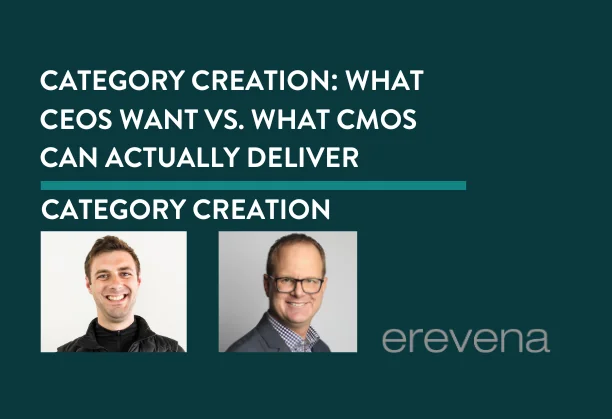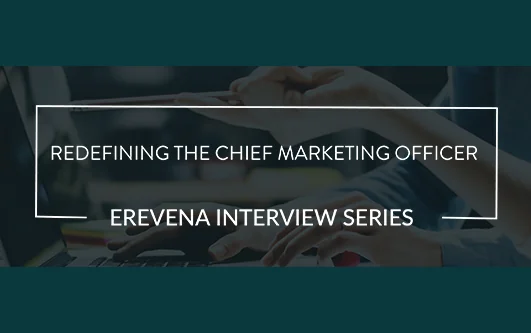Terry Shaw and Scott Brown of Cervin Ventures on navigating the complex world of category creation
Introduction
“Category creation” has become one of the most talked-about, and misunderstood, ambitions in tech. Founders are asking CMOs to deliver it. Boards want to see it. But few fully grasp what it truly requires.
In this candid conversation, Terry Shaw sits down with Scott Brown, head of platform services at Cervin Ventures and former CMO at Sapphire Ventures, to unpack what CMOs need to know when category creation becomes an executive expectation. This discussion is equally useful for CEOs hiring marketing leaders and considering whether they are truly ready to shape a new market.
The Misalignment Problem
Scott Brown describes category creation as “the paradigm shift term of the 2020s”. It’s the kind of buzzword that has surged up the CEO and founder agenda, often without a clear understanding of what it means.
The challenge is that most founders have been trained to manage their businesses through short-term, measurable tactics. Category creation, by contrast, is a long-term strategic endeavour.
As Shaw puts it, “The term itself is framing something so big-picture, something inherently long-term, that it’s causing internal friction with the founder. Most startup founders are traditionally technically minded. And they have generally learned, by necessity, to manage their business — changing month to month, quarter to quarter — by focusing on readily measurable tactics of execution… which leads to mis-assessment… and invariably, organ rejection.”
The result: marketers are hired with ambitious briefs to “create a category”, only to discover that the internal alignment and long-term thinking required simply isn’t in place.
What Category Creation Really Means
Brown is clear that this isn’t just a marketing label or positioning exercise.
“It’s more than just creating a new label. It’s a framework and a way to think about where the world is headed. It’s not just a moniker, or a catchphrase. It is really about you as an executive team and as an organization calling the shot for where you think the world is going, and then trying to contextualise that for everybody who doesn’t see it yet.”
He describes it as “lightning in a bottle”. Success comes from timing, conviction, and the long-term commitment to create, sponsor, and propagate a conversation in the market. It’s not a one-time video or flashy asset. It’s about changing how people think — and doing the hard work to sustain that shift.
Red Flags and Reframing the Conversation
So, what should a CMO do if a CEO brings up category creation in an interview?
“If any CEO asks me specifically about category creation, that’s a red flag for me,” Brown says. “Unless they are able to actually outline their thinking of what they mean and why they want it — and what they’re willing to do to earn it — it means they’re just asking about a buzzword.”
Rather than going along with the term, Brown advises CMOs to reframe the conversation. Ask deeper questions:
- Why was this company founded?
- What’s the unique insight behind the product?
- What social, economic, or technological trend is the company responding to?
True category creation is about building a solution for the future, not just rebranding the past. And it can’t be the CMO’s responsibility alone.
“Product has to align to this vision. Your go-to-market motion has to align. Your executive vision of where the company’s headed — they all have to align.”
The CEO’s Role: From Sponsor to Evangelist
Category creation starts with the CEO. Not necessarily as a charismatic stage presence, but as someone who consistently communicates a long-term vision both internally and externally.
“If they are not living and breathing that vision — and they’re baking that into the DNA and culture of the business — your chances of success are cut in half right out of the gate,” Brown says.
He encourages CEOs to develop a “political stump speech” — a clear, repeatable message that outlines where the world is going and why customers should “vote” for their company.
“I like to tell marketers who get charged with these kind of efforts to be prepared: the time that you are sick and tired of saying the same exact thing is about the time you have a customer say, ‘Wow, that’s really interesting, I’ve never heard that before.’”
This kind of consistency is often at odds with startup culture, which is conditioned to seek novelty and fast results. But if a founder isn’t ready to repeat the story for months, or years, it’s unlikely to catch on.
Setting Realistic Expectations
As Shaw puts it, “This whole topic, if we zoom out, can only have successful execution assigned to it retrospectively, rather than be tracked and measured as moving in the right direction in the moment.”
This is why it’s so important for CMOs to set the right time horizon — or educate the founder around it. If a CEO expects to track quarter-by-quarter ROI on a category creation effort, the outcome is likely to disappoint.
Brown offers a reminder that some of the strongest market-defining narratives are the ones that evolve over time with new proof points and data. Marketers must build a flexible framework that can incorporate these new insights as they emerge.
Power Dynamics and Role Clarity
Shaw notes that for this approach to work, the CEO must be open to the CMO’s steer — and both parties need clarity on roles and expectations.
“The CEO needs to be open to listening and taking that steer from the CMO, allowing the CMO to be the puppet master to a degree. Because they become a very valuable asset as part of the marketing mix. That power dynamic needs to be understood, and done so in a non-emotional way.”
Brown agrees that the CMO is less the solo evangelist and more the orchestrator or project manager.
“Again, the CEO or the founder doesn’t have to be the only evangelist… but if you don’t have that vision tightly defined, with product and go-to-market aligned to it, I’m not sure there’s enough substance for the CMO to build a category around.”
Signs of Progress
One of the first signs that your narrative is starting to land? Pushback.
“I believe one of the first signs of success for category creation is when you get people to disagree with you,” Brown says. “I think your vision of the world is wrong. Okay, great. Let’s have that conversation.”
And if a CEO insists on being the only company in the category?
“It’s not a category. It’s a sales pitch.”
A true category needs to be broad enough to include other players. That’s what enables meaningful debate, adoption, and momentum. When others begin to repeat, challenge, or build on your story — that’s when traction begins.
Conclusion: Rethinking Category Creation as a Team Sport
Whether you’re a CMO interviewing for your next role or a CEO considering how to reshape your market, this conversation offers a reality check on what category creation actually takes.
It is not a quick-win marketing campaign. It is a long-term, organisation-wide commitment that starts with the CEO and demands alignment across product, go-to-market and culture.
As Shaw puts it, “It’s more about ‘I can help you be the custodian of setting the new narrative’. It’s still going to sit with you.”
And Brown adds, “If the interview process is to show the CEO a project plan to create a category, it’s a nonstart. There is no secret checklist. It is lightning in a bottle. It’s being in the right time, the right place, with the right story, and having the fortitude to keep telling that story, even as you’re constantly evolving it with new data points.”
Get in touch
At Erevena, we work closely with CEOs and CMOs to build leadership teams that shape new markets and scale with clarity.
If you’re thinking about how to define your category, or hiring the people to help you do it, feel free to reach out to Terry Shaw. We’d love to hear what you’re working on.
Editor’s note: This conversation was originally recorded at the end of 2024 and shared as a transcript soon after. We’re revisiting it now to bring fresh attention to a topic that’s only become more relevant for CEOs and CMOs navigating the realities of category creation.
Share this article:













